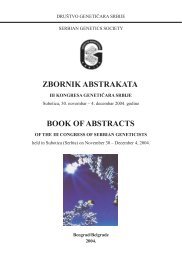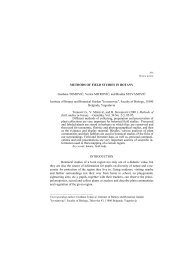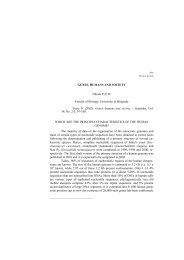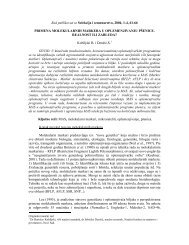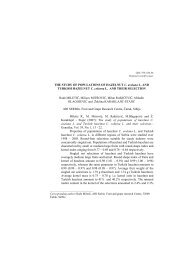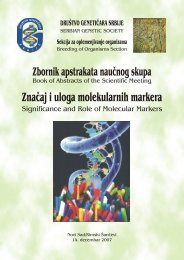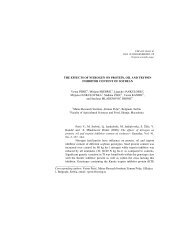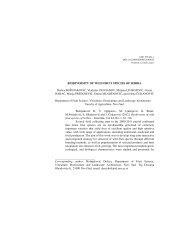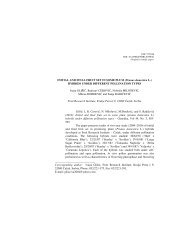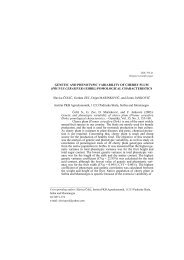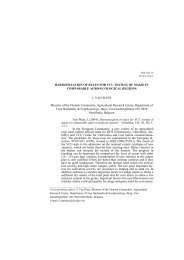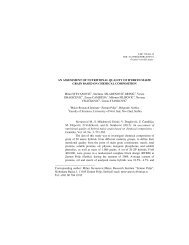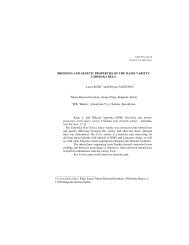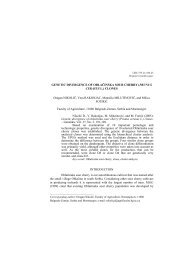Jelena Pajic;Deligradska 29, 11 000 Beograd, tel: +381 ... - doiSerbia
Jelena Pajic;Deligradska 29, 11 000 Beograd, tel: +381 ... - doiSerbia
Jelena Pajic;Deligradska 29, 11 000 Beograd, tel: +381 ... - doiSerbia
Create successful ePaper yourself
Turn your PDF publications into a flip-book with our unique Google optimized e-Paper software.
122 GENETIKA, Vol. 45, No.1,121-133, 2013<br />
The perfect pesticide should be toxic only to target organisms, be totally biodegradable<br />
to CO2 and H2O, and should not leave intermediate compounds in environment. Unfortuna<strong>tel</strong>y,<br />
this is rarely the case and widespread use of pesticides in the contemporary agriculture is of<br />
increasing concern. The main problems in real system arising from the use of pesticides in<br />
agriculture are their toxicity to non-target organisms and environment (ROS et al., 2006;<br />
RADIVOJEVIC et al., 2008; RADIVOJEVIC et al., 2012).<br />
Large amounts of these chemicals are released into the environment and being a<br />
potential hazard to human health. Toxicologic evidence of the carcinogenicity of several<br />
pesticides in animals, together with the fact that a large population of workers are exposed to<br />
such compounds, have attracted the attention of many studies (CARBONELL et al., 1995;<br />
PADMAVATHI et al. 2<strong>000</strong>; GOMEZ-ARROYO et al., 2<strong>000</strong>; ZELJEZIC et al., 2002; UNDEGER et al.,<br />
2002; GROVER et al. 2003; HEUSER et al. 2007; JOVICIC et al., 2012). With regard to genotoxicity,<br />
particular attention is focused on cytogenetic assays, because chromosome aberrations may be<br />
used as an early warning signal for cancer development. Data from the biomonitoring of human<br />
populations indicate that the increased frequency of chromosome aberrations is related to<br />
exposure to genotoxic agents, and may be employed to estimate cancer risk and genetic illness<br />
(WHO, 2004; HAGMAR et al. 2004). Biomonitoring studies using somatic cells have been<br />
extensively conducted to evaluate the possible genotoxic risk of a defined exposure and some<br />
indicators, such as chromosomal aberrations, have been shown to be relevant biomarkers for<br />
further cancer incidence (HAGMAR et al. 1998; IARC, 2007).<br />
Using data from cytogenetic biomonitoring studies for risk assessment has many<br />
potential disadvantages, such as the difficulty of establishing consistent causal exposure-disease<br />
relationships, problems in obtaining reliable information on exposure levels in retrospective<br />
studies, overlapping contact with other chemicals and/or the problem of non-comparable<br />
populations among those exposed to different levels of carcinogens (HCN, 1994). Moreover, in<br />
the case of occupational contact with pesticides, there is great interindividual variability in the<br />
degree of exposure and it generally involves complex mixtures of many kinds of compounds.<br />
Exposure to pesticides has been associated with increases in the incidence of non-Hodgkin ´ s<br />
lymphoma (HARDELL et al. 1999; ZHENG et al. 2001), pancreatic, stomach, liver and bladder<br />
cancer (SHUKLA et al. 2001; JI et al. 2001), Parkinson´s disease (GAUTHIER et al. 2001) and<br />
undesirable reproductive outcomes (ARBUCKLE et al. 2001) among others.<br />
Many pesticides involved in carcinogenic risk, and classified as probable or possible<br />
carcinogens by International Agencies, are banned or their use is restricted in some countries;<br />
but, due to bioaccumulation and persistence in ecosystems, they are widespread environmental<br />
pollutants. Residues of pesticides have been detected in the food chain and in different biological<br />
media in humans.<br />
In order to identify possible changes related to pesticide exposure, we have carried out a<br />
cross-sectional study in a group of occupationally exposed workers, where cytogenetic,<br />
biochemical and hematological parameters were analyzed simultaneously.<br />
MATERIALS AND METHODS<br />
The exposed group was composed of 26 individuals working in three different units of<br />
pesticide production (pesticide synthesis, emulsion concentrated production and powder and<br />
liquid pesticide production) and 32 controls. During the production process all subjects were<br />
simultaneously exposed to a complex mixture of pesticides (Table 1). No control individuals



